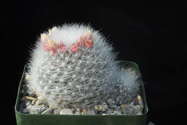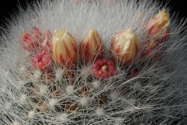This choice montane species is desirable for its soft, pettable spination, like the bristles of a soft tooth brush. Radial spines number 35 to 40 and form a dense network mostly concealing the globular bodies. Central spines number 8 or 9 and can be red-tipped or entirely reddish, giving the plants a chesnut-brown cast. However, plants with glassy white spination are most commonly seen in cultivation and are what is offered here. Mature clusters can number up to 50 heads. The species was described in the British C&S Journal by Ernest William Shurly in 1949 and was named for its discoverer, Fritz Schwarz. Locality information provided was rather vague: “the species grows at a height of 2000 meters, more or less, in the north of the state of Guanajuato, Mexico, high up between cliffs in good soil; the midday sun only gets to the plant for a short time.” American expatriates Walter and Betty Fitz Maurice took on the mission of resolving various mammillaria mysteries, including the precise origin of the type locality of M. schwarzii. Having befriended Mr. Schwarz, they were able to extract the suggestion to look in the mountains near San Felipe. Their success was reported in the Cactus and Succulent Journal, 60(2):72-75 (1988) and allowed for expansion of the description to encompass variation observed and clarification as to habitat; plants were observed on exposed cliff faces as well as in shaded crevices. The bright light of its high mountain habitat might suggest that the dense spination serves to protect the plants from sunburn and that is undoubtedly true. However, the fact that the plants also grow in shaded crevices makes one wonder what a mealybug’s-eye-view (watch for those!) might be like from the surface of the epidermis. Perhaps the translucent spines are equally effective at diffusing light, rather like fiber optics, affording the plants enough by which to photosynthesize even in shady crevices. Six years later the Fitz Maurices reviewed the status of M. schwarzii in habitat in the Cactus and Succulent Journal 66(3): 107-109 (1994). This article offers one of the most cogent descriptions ever written of the threats to these plants’ continued survival and a moving mea culpa as to how providing well-documented habitat information can lead to exploitation by unscrupulous collectors. There really are enough of these plants in cultivation to satisfy demand for present and future generations without ever collecting another from the wild. It is our sincere hope that those who order these plants will find them to be a source of enjoyment and will contribute to the wider body of knowledge about how to grow and propagate them successfully so that the species will be conserved ex situ (in cultivation) as well as in situ (in habitat). We offer robust seedlings beginning to cluster. HBG 93987, $6.

Published in the Cactus and Succulent Journal, Vol. 88 (3), May-June, 2016

